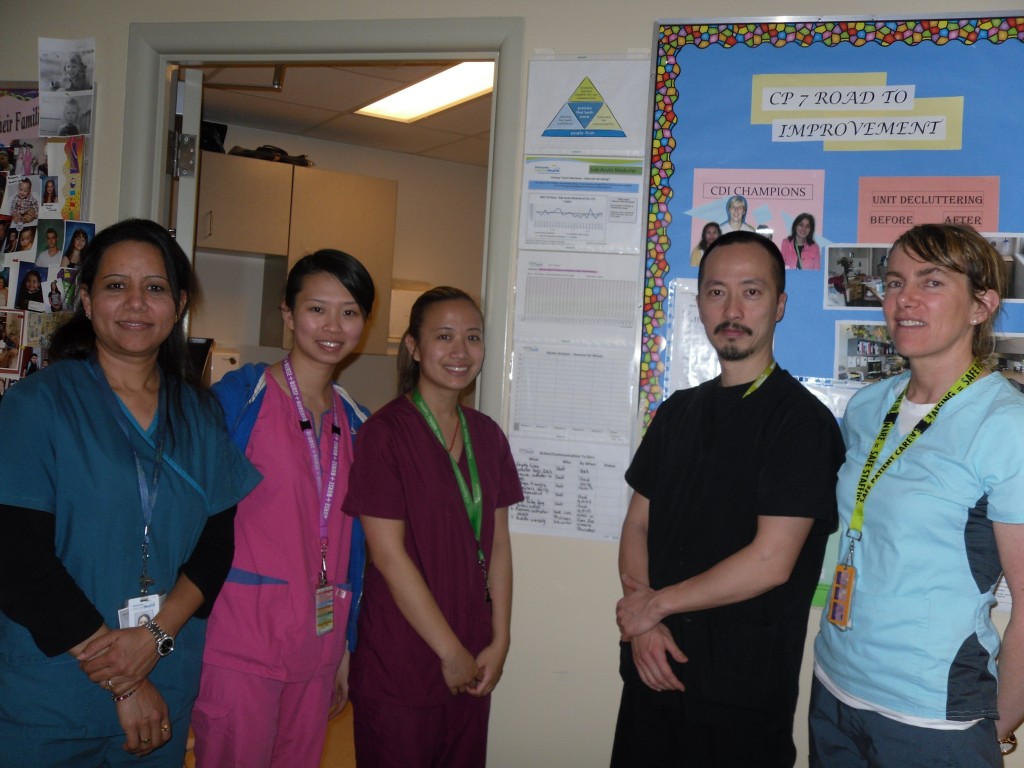
On the CAUTI frontline: nurses from the 7th floor of the Centennial Pavilion at VGH. Left to right: Sharanjit Poonia, RN, Alice Chan, LPN, Nancy Ly, LPN, Bernard Wong, LPN and Beth Donevan, RN.
Over the past four years, more than 80 per cent of VCH’s urinary tract infections (UTIs) were catheter caused, impacting patient experience and care by increasing overall length of stay. These infections are also a significant cost pressure on the organization.
“If a patient has a catheter associated urinary tract infection (CAUTI), it can extend their stay at the hospital by many more days, impacting recovery of already sick patients and adding to nursing work load,” says Prab Gill, Acting Director for Professional Practice Nursing at VCH. “And on top of that, there can be complications from the antibiotics to treat the infection – we don’t want our patients to go through that.”
This is why VCH has refocused their efforts on reducing CAUTI by striking a Regional Steering Committee dedicated to reducing the number of infections by 25% over the next fiscal year and on an ongoing basis.
As part of a larger VCH quality improvement initiative, the CAUTI Team is working with other key quality improvement programs to leverage the skills and dedicated commitment of frontline staff in reducing the number of hospital acquired infections.
VCH Regional CAUTI Project is being rolled out with a phased approach. Phase 1 has been focused at Vancouver Acute (VA). Phase 2 roll out will involve Coastal CoC.
During Phase 1 roll out at VA the project moved forward in two waves. Wave One work started last summer with 9 clinical areas/programs (GFS, ACE, SAM, Ortho Trauma/Recon, ED, OR, BPTU, Spine, and PACU). These areas are currently in the action planning/implementation phase with frontline staff input, considering quick wins in their areas and how to put best practices into action. The second wave at VA, involves 11 clinical areas/programs (AMU, TCU, Palliative, Resp/Thoracics, Gyne/Uro/SOT, Gen Surg / Vascular / ENT, Hip/Knee/SSU (UBCH), ICU, OR (UBCH), Neuro/Neurosx, Cardiac Surgery/CSICU/CCU). Wave 2 work has just started in January and is currently in the data collection period.
All of these clinical areas are focusing on four key drivers to prevent or at least reduce CAUTI in their patients. These include: avoiding the use of catheters all together, inserting the catheter using aseptic (or sterile) technique, following new guidelines for care and management such as securement of catheters and increased change of urine emptying containers, as well as daily and ongoing review of catheter necessity and removing them quickly when not needed.
Gill says that the staff and leadership teams in all clinical areas at VA recognize the need for quality improvement and are highly committed to reducing CAUTI in their areas. She adds that the work has just started but the level of engagement from our staff is overwhelming and we are highly optimistic that we will see positive results very soon.
“I feel like we have a lot of momentum,” she says. “Clinical teams (including allied health, nursing staff, and physicians), are definitely committed and we will be seeing less CAUTI because of it.”
Gill says there is a regional plan to move this work forward to other Communities of Care and other care sectors within VCH. Learnings from this project at VA will inform our regional work within rest of VCH.
“There’s a lot of good work being done now that will ensure we are providing the best care to our patients.”
